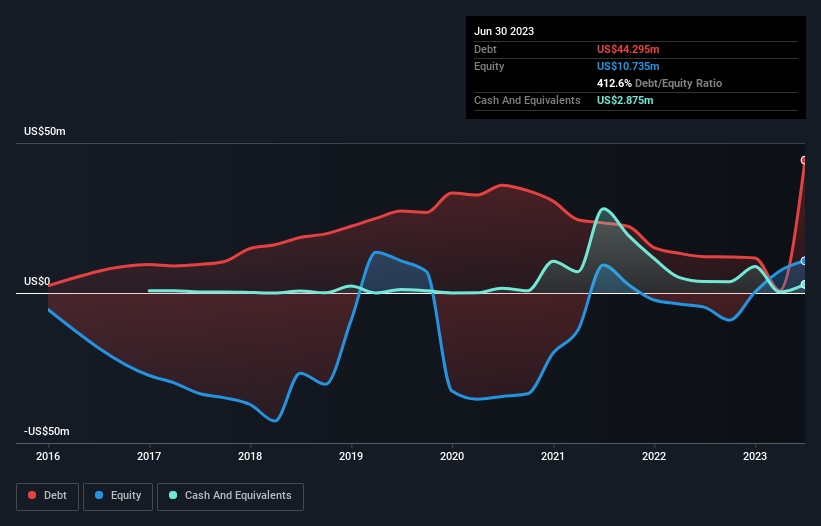- United States
- /
- Oil and Gas
- /
- NasdaqCM:AREC
Does American Resources (NASDAQ:AREC) Have A Healthy Balance Sheet?
David Iben put it well when he said, 'Volatility is not a risk we care about. What we care about is avoiding the permanent loss of capital.' It's only natural to consider a company's balance sheet when you examine how risky it is, since debt is often involved when a business collapses. As with many other companies American Resources Corporation (NASDAQ:AREC) makes use of debt. But the more important question is: how much risk is that debt creating?
Why Does Debt Bring Risk?
Generally speaking, debt only becomes a real problem when a company can't easily pay it off, either by raising capital or with its own cash flow. In the worst case scenario, a company can go bankrupt if it cannot pay its creditors. However, a more common (but still painful) scenario is that it has to raise new equity capital at a low price, thus permanently diluting shareholders. Of course, debt can be an important tool in businesses, particularly capital heavy businesses. When we think about a company's use of debt, we first look at cash and debt together.
See our latest analysis for American Resources
How Much Debt Does American Resources Carry?
As you can see below, at the end of June 2023, American Resources had US$44.3m of debt, up from US$12.1m a year ago. Click the image for more detail. However, because it has a cash reserve of US$2.87m, its net debt is less, at about US$41.4m.

How Strong Is American Resources' Balance Sheet?
According to the last reported balance sheet, American Resources had liabilities of US$16.2m due within 12 months, and liabilities of US$73.1m due beyond 12 months. On the other hand, it had cash of US$2.87m and US$995.2k worth of receivables due within a year. So its liabilities outweigh the sum of its cash and (near-term) receivables by US$85.5m.
This deficit is considerable relative to its market capitalization of US$109.5m, so it does suggest shareholders should keep an eye on American Resources' use of debt. This suggests shareholders would be heavily diluted if the company needed to shore up its balance sheet in a hurry. There's no doubt that we learn most about debt from the balance sheet. But it is future earnings, more than anything, that will determine American Resources's ability to maintain a healthy balance sheet going forward. So if you want to see what the professionals think, you might find this free report on analyst profit forecasts to be interesting.
Over 12 months, American Resources made a loss at the EBIT level, and saw its revenue drop to US$25m, which is a fall of 23%. That makes us nervous, to say the least.
Caveat Emptor
While American Resources's falling revenue is about as heartwarming as a wet blanket, arguably its earnings before interest and tax (EBIT) loss is even less appealing. Indeed, it lost a very considerable US$26m at the EBIT level. When we look at that and recall the liabilities on its balance sheet, relative to cash, it seems unwise to us for the company to have any debt. Quite frankly we think the balance sheet is far from match-fit, although it could be improved with time. For example, we would not want to see a repeat of last year's loss of US$350k. In the meantime, we consider the stock very risky. There's no doubt that we learn most about debt from the balance sheet. However, not all investment risk resides within the balance sheet - far from it. Case in point: We've spotted 2 warning signs for American Resources you should be aware of.
At the end of the day, it's often better to focus on companies that are free from net debt. You can access our special list of such companies (all with a track record of profit growth). It's free.
New: Manage All Your Stock Portfolios in One Place
We've created the ultimate portfolio companion for stock investors, and it's free.
• Connect an unlimited number of Portfolios and see your total in one currency
• Be alerted to new Warning Signs or Risks via email or mobile
• Track the Fair Value of your stocks
Have feedback on this article? Concerned about the content? Get in touch with us directly. Alternatively, email editorial-team (at) simplywallst.com.
This article by Simply Wall St is general in nature. We provide commentary based on historical data and analyst forecasts only using an unbiased methodology and our articles are not intended to be financial advice. It does not constitute a recommendation to buy or sell any stock, and does not take account of your objectives, or your financial situation. We aim to bring you long-term focused analysis driven by fundamental data. Note that our analysis may not factor in the latest price-sensitive company announcements or qualitative material. Simply Wall St has no position in any stocks mentioned.
About NasdaqCM:AREC
American Resources
Engages in the production of rare earth and critical mineral concentrates for the infrastructure and electrification markets.
High growth potential with low risk.
Market Insights
Community Narratives



